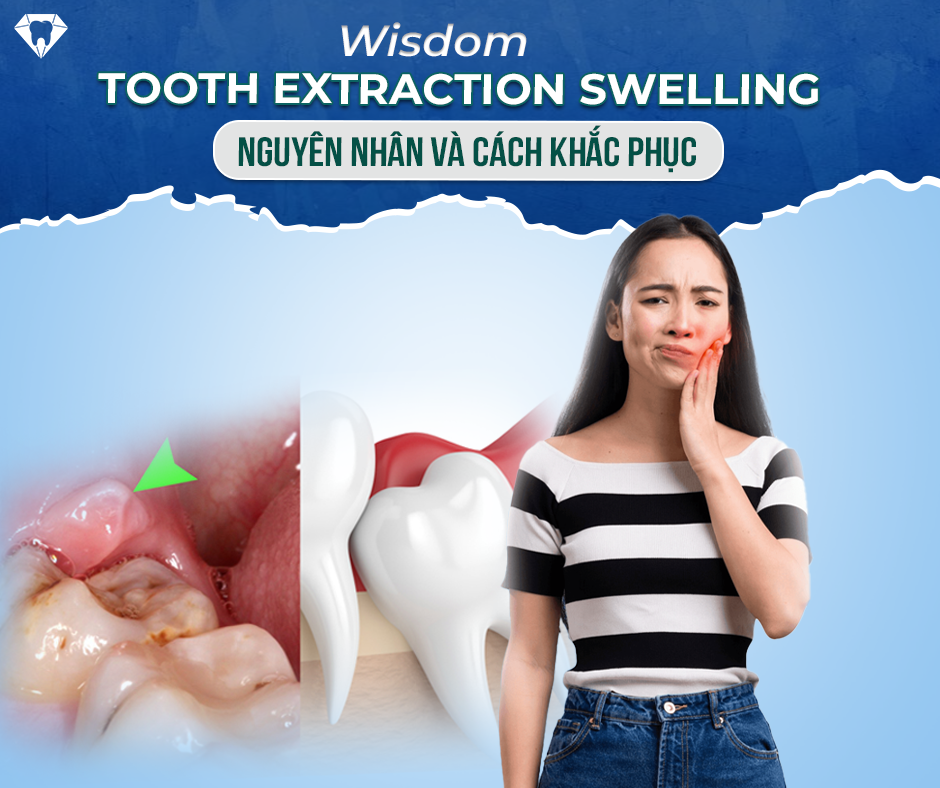Wisdom tooth extraction is a common dental procedure, but it often comes with temporary discomfort, including facial swelling. Many people wonder why wisdom tooth extraction swelling, how long it takes to subside, and what can be done to alleviate it quickly. Understanding the causes of swelling and applying effective remedies can help speed up recovery. In this article, Joy International Dental Clinic will provide comprehensive information on post-extraction swelling and the best ways to manage it effectively.
1. Does Wisdom Tooth Extraction Cause Swelling?

Yes, wisdom tooth extraction frequently leads to swelling. This is a natural response of the body to tissue trauma and inflammation following the surgical removal of the tooth. The severity of the swelling depends on various factors, including the complexity of the extraction, an individual’s healing ability, and post-operative care.
In cases where the wisdom tooth is impacted, positioned deep within the gum line, or requires surgical removal of surrounding bone, swelling is typically more pronounced. It is essential to understand that this swelling is temporary and will gradually subside as the healing process progresses. However, proper care is necessary to prevent complications such as prolonged inflammation or infection.
2. Causes of Swelling After Wisdom Tooth Extraction

Several factors contribute to facial swelling after a wisdom tooth extraction. Below are the primary reasons:
2.1 Inflammatory Response
After the extraction, the body initiates an inflammatory response to promote healing. This results in increased blood flow to the affected area, causing swelling and slight discomfort. The inflammation typically peaks within the first 48 hours and then gradually subsides.
2.2 Soft Tissue Trauma
The removal process may involve cutting the gum tissue and, in some cases, drilling into the jawbone to extract the tooth. This can lead to swelling as the body works to repair the damaged tissues.
2.3 Blood Clot Formation and Healing
After extraction, a blood clot forms at the site to protect the wound and promote healing. If this clot is disturbed—due to vigorous rinsing, smoking, or using a straw—it can lead to complications such as dry socket, resulting in prolonged pain and swelling.
2.4 Individual Healing Process
Each person’s body reacts differently to surgical procedures. Some individuals may experience minimal swelling, while others may have significant swelling due to differences in immune response and healing rates.
2.5 Infection or Complications
In rare cases, excessive swelling accompanied by pain, pus, or fever may indicate an infection. This requires immediate dental attention to prevent further complications.
3. How Long Does It Take for Swelling to Subside?
The duration of swelling varies based on the complexity of the extraction and individual healing factors. Below is a general timeline:
- Day 1-2: Swelling and discomfort peak due to the body’s inflammatory response.
- Day 3-4: Swelling begins to decrease, and pain becomes more manageable.
- Day 5-7: Significant reduction in swelling, with most symptoms improving.
- After 1 week: Minimal to no swelling remains if proper care is taken.
In cases where swelling persists beyond one week or worsens, a follow-up with a dentist is necessary to rule out complications.
4. Effective Remedies to Reduce Swelling After Wisdom Tooth Extraction
Proper post-extraction care can significantly reduce swelling and speed up the healing process. Here are some highly effective methods:
4.1 Wisdom tooth extraction swelling, so apply cold compress to reduce it

Applying a cold compress within the first 24-48 hours is one of the most effective ways to reduce swelling.
How to do it:
- Wrap ice in a clean towel or use a cold pack.
- Apply to the affected area for 15-20 minutes, then take a 10-minute break before reapplying.
- Repeat several times throughout the day to minimize swelling.
4.2 Warm Compress (After 48 Hours)

Once initial swelling subsides (after 48 hours), switching to a warm compress can improve blood circulation and promote faster healing.
How to do it:
- Use a warm towel or heat pack.
- Apply gently to the affected area for 15-20 minutes.
- Repeat 2-3 times daily as needed.
4.3 Saline Rinse for Oral Hygiene
A saline rinse helps keep the extraction site clean and reduces the risk of infection.
Instructions:
- Mix 1 teaspoon of salt with a glass of warm water.
- Gently swish the solution in your mouth 2-3 times daily.
- Avoid aggressive rinsing to prevent disturbing the healing clot.
4.4 Medication and Pain Management

Dentists typically prescribe pain relievers and anti-inflammatory drugs to manage post-extraction symptoms.
Important considerations:
- Take medications as prescribed to control pain and swelling.
- Do not self-medicate without consulting a dentist.
- If antibiotics are prescribed, complete the full course to prevent infection.
4.5 Proper Diet for Faster Healing
Eating the right foods can support recovery and prevent irritation at the extraction site.
Recommended foods:
- Soft foods such as soups, porridge, mashed potatoes, yogurt, and smoothies.
- Hydrating drinks like coconut water, fresh juices, and herbal teas.
Foods to avoid:
- Hard, crunchy, or spicy foods that may irritate the wound.
- Hot beverages that can disrupt clot formation.
- Alcohol and carbonated drinks, which may delay healing.
4.6 Rest and Avoid Strenuous Activities
Physical exertion can increase blood flow and prolong swelling. It is best to:
- Get adequate rest in the first few days after extraction.
- Avoid strenuous exercise or bending over, as this may lead to post-extraction bleeding.
5. Essential Post-Extraction Care Tips
To ensure smooth healing and minimize complications, follow these additional care tips:
- Avoid smoking or using straws for at least a week, as suction can dislodge the blood clot.
- Do not touch the wound with fingers or tongue to prevent infection.
- Keep your head elevated while sleeping to reduce swelling.
- Stay hydrated but avoid drinking directly from a bottle.
- Contact your dentist immediately if you experience excessive swelling, pus discharge, or fever.
6. When to Seek Professional Help?
While mild swelling is normal, seek dental care if you notice:
- Swelling that worsens after 3-4 days.
- Severe, throbbing pain that does not improve with medication.
- Pus discharge or an unpleasant taste in the mouth.
- High fever or chills.
- Difficulty breathing or swallowing.
These symptoms may indicate an infection or other complications requiring professional treatment.
Conclusion
Swelling after wisdom tooth extraction is a normal part of the healing process, but it can be effectively managed with proper care. Using cold compresses, maintaining good oral hygiene, taking prescribed medications, and following dietary guidelines can significantly reduce swelling and speed up recovery. However, if symptoms persist or worsen, visiting a dental clinic for professional assessment is crucial. If you have any concerns, don’t hesitate to contact Joy International Dental Clinic for expert advice and care.






